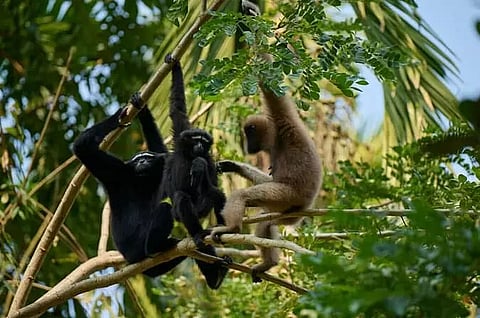
- Home
- Live Blog
- Breaking News
- Top Headlines
- Cities
- NE News
- Sentinel Media
- Sports
- Education
- Jobs

OUR CORRESPONDENT
TINSUKIA: Electrocution that rendered a juvenile Hoolock Gibbon fatally injured in the Dighal Haku area of Barekuri under Tinsukia district last Thursday evoked widespread concern among the wildlife activists.
Lovingly named Twik by the locals, it got electrocuted and injured its left arm in non-capsulated open wires while brachiating with its parents. The incident was first reported by Mohit Chutia, a resident of Dighal Haku, who has been feeding and taking care of the gibbon family consisting of male, female and a juvenile in his backyard upon hearing the cries of Twik. Ragini Nath, a wildlife documenter who was present nearby was contacted by Mohit Chutia. They later informed the district wildlife and veterinary departments.
Dr Khanin Changmai, a veterinarian from Wildlife Trust of India, has been treating the injured juvenile with antibiotics and painkillers injected in bananas as it became difficult for authorities to capture or tranquilise the gibbon. With the injured juvenile using only three limbs to move across canopies, the movement of the gibbon family has been restricted to a smaller area. Though it responded to the medicines but is not out of danger, said Ragini Nath.
Electrocution, deforestation and growing development of hydrocarbon exploration continue to pose imminent danger for the Hoolock Gibbon's long-term survival in local ecosystems like Barekuri. Despite concerted efforts made by villagers to conserve the survival of gibbons in Barekuri, long term conservation of Hoolock gibbons would not be possible without government bodies working together with the villagers. Mohit has been raising his voice for several years to get cables installed in electric wires. However, his appeals have met with only apathetic government bodies. According to Mohit, another juvenile gibbon was electrocuted and killed on the same open electric wires four years ago. Yet there has not been any effort by the electricity or wildlife departments to cover the open electric wires for the free movement of the gibbons. Over the last decade, most gibbon deaths are caused by electrocution in open wires and there continue to be several regions where installation of cables in electric wires remains incomplete. There is also an allegation that villagers cut electric wires and are involved in pilferage of electricity through the open wires.
There needs to be an urgent unanimous action to be taken to conserve the endangered ape species in their local habitat, opined Nath. Over the last few decades the number of gibbons in Barekuri has dwindled with only 19 surviving gibbons out of which only four are female. The species being monogamous and absence of a partner may threaten the survival of endangered gibbons in Barekuri. Community conservation is the need of the hour. Presently, a section of locals is allegedly reaping the benefits while depriving the families who have been caring for the gibbons in their own courtyards.
Also watch: